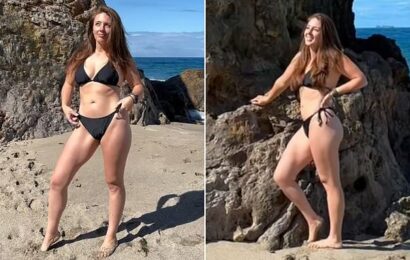In February of 1997, a Procter & Gamble engineer ducked into a meeting with the company's chief technology officer, a smile on his face, and a secret in his pocket: a strip of translucent food wrap coated in a peroxide whitening solution.
Inspired by public interest in dental whitening procedures — and in part by the fact that Colgate was "cleaning their clocks" in the R&D department — P&G, the behemoth behind Crest, had assigned Paul Sagel the task of whitening American smiles independent of American dentists. Just a few decades before, the concept of at-home teeth whitening barely existed. It was discovered by accident when a dentist administering trays of peroxide-rich Gly-Oxide to help treat his patients' gums observed that it also made their teeth beam. By the late '80s, the price of a white smile was about $800, plus seven or so nightly hours of steeping one's teeth in goopy carbomide peroxide contained in a custom-fit tray.
Sagel's main concern as he worked on his new assignment: the delivery system. (His specialty was diffusion technology. As an undergrad, he designed artificial kidneys, mimicking the organ's magnificent blood filtration system for dialysis patients.) "We ran a small study and sure enough, peroxide trays do work," he recalls. "Peroxide is a wonderful whitening agent. But there was a diffusion problem."
Sagel describes the tooth's structure as resembling a glass-top table or, in the tooth's case, yellow dentin covered with translucent ivory enamel. Hydrogen peroxide whitens by getting down to the tooth's dentin, which takes time. Sagel discovered that concentration drove performance — the more peroxide you could safely wear, the less time it would take to bleach. Crest declines to confirm the percentages they use today, but one 2004 study from the University of North Carolina and P&G identified a range from 6 percent (in wimpier formulas) to 14 percent (for a more nuclear white) hydrogen peroxide.
Yet, while it works, peroxide cannot be bothered, least of all by saliva, which contains compounds that break peroxide down into oxygen and water. To properly diffuse into the tooth, P&G's hydrogen peroxide solution needed a barrier that could keep spit out long enough for mission completion. The original Crest Whitestrips were composed of a thicker, textured, plastic wrap called Impress — the offspring of Saran wrap and the paper towel — that P&G was grooming to conquer the plastic food-wrap category. But in the dental-care industry, the arrival of Whitestrips on drugstore shelves in 2001 amounted to a tectonic shift, earning $200 million in its first year and close to a 90 percent market share in what would become a multibillion-dollar category.
The history of the human tooth is long in the tooth, but the history of human tooth decay is much shorter; about as old as the Industrial Revolution and commodified sugar. (Incidentally, the period of human history widely considered by environmental scientists to have kicked off the climate crisis also appears to have inspired contemporary dentistry.) Before Whitestrips, the dental-care market was about oral hygiene and generally keeping teeth from falling out of our mouth. After Whitestrips, its main focus was making those undecayed teeth gleam.
"I graduated dental school in 1983, and it's funny," says William Dorfman, a cosmetic dentist in the Beverly Hills area and arguably the father of contemporary tooth whitening, "that ninety-nine percent of what I do in my practice today are things that weren't even invented [then]." Just after the Whitestrip entered the American mouth, in 2003, Dorfman was cast on ABC's Extreme Makeover, where he introduced American eyes to the transformative powers of unprecedentedly white teeth. On the show's first episode, he bleached three sets of teeth using a proprietary laser-activated process called Zoom whitening. About seven years later, he and his partners sold the technique to Philips for an amount he coyly refuses to disclose. (Later, he is less coy: Zoom sold for close to $200 million.)
The history of the human tooth-decay epidemic is about as old as the Industrial Revolution.
Let me be enamel-clear: There is no health imperative to having white teeth. And a tooth's health cannot generally be measured by its whiteness. "Our teeth naturally become discolored. That's normal," says dental anthropologist Peter Ungar. "It's not considered attractive or appealing in our culture, but that's the way it is." A tooth's natural shade is actually a symphony of reds and oranges and greens, each muting one another into a hue that can vary as much as skin tone, albeit on a much shorter gradient — from ecru to terra-cotta. A 2018 study describing a correlation between teeth, skin, and eye color should perhaps serve as a dazzling reminder of gorgeous human variance. Instead, it endeavors to help cosmetic dentists select more skin-flattering shades of white.
Since Crest's Whitestrips struck gold, nearly every other dental brand in existence has rushed to the pearly spring, mining the world of its charcoal and clay deposits and Andalusian diamond-studded orchids, cramming them into on-the-go whitening pens and foams and tiny, disposable, moist towelettes. In its turbulent 20s, over-the-counter whitening is still embracing experimentation. Even Sagel is moving on from stripping. His latest project, Crest Whitening Emulsions, delivers a dose of peroxide to enamel like dew to a flower petal, eschewing the strip system completely.
While most of these products endeavor to do all this in an enamel-safe, dentin-protecting way, many who have whitened their teeth can attest to experiencing related discomfort. Whitestrips warn of potential gum discomfort and tooth sensitivity; a direct-to-consumer whitening kit comes with a formula claiming to "help calm the nerve" as LED light aggravates all that peroxide.
There is a standardized scale for ranking the might of a toothpaste. Its Relative Dentin Abrasivity, or RDA value, is calculated by measuring dentin loss caused by a particular toothpaste against a reference RDA of 100. Baking soda has an RDA of 7; Sensodyne ProNamel reportedly scores around a 34; Colgate's regular toothpastes are said to hover around 70. The scale tops out at 200 (the recommended Food and Drug Administration limit) and then really tops out at 250 (the American Dental Association limit). The ADA and some dentists consider everything under 250 RDA to be enamel-safe. Others, like Brian Harris, a cosmetic dentist in Phoenix, caution against anything above 100. "I like at 70 or below," he says. Harris also lays out the horrifying paradox of over-whitening: As translucent enamel is worn away, more of a tooth's soft, yellow dentin is exposed, which in turn prompts greater whitening efforts.
Only toothpastes are ranked for RDA. In 2016, with people bleaching their teeth "more than ever before," the American Dental Association published standard No. 136, to help assure enamel and soft-tissue safety, among other considerations, by creating requirements to allow whitening products to get an ADA seal. As of December 2020, only three bleaching products on the market have received the seal: Crest 3D White Whitestrips, Crest 3D Whitestrips Gentle, and Crest 3D Whitestrips Classic Vivid.
Compared with human history, the era of white teeth is minuscule, Ungar says — a pearly glimmer in the fossil record. And, at least under current cosmetic standards, he does not foresee any long-term negative effects from whitening, meaning we are free to bleach without fear. Lucky us.
Source: Read Full Article






